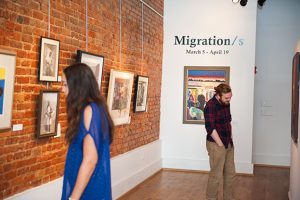Interdisciplinary Collaboration Leads to Spring Exhibition

From the 2013 Celebrating Excellence | One of the nation’s most historical population movements, the Great Migration of 1915-1970, is being studied this year by UA students from a variety of disciplines through works of art in the College’s Paul R. Jones Collection of American Art.
At the request of Dean Robert Olin, College faculty were asked to develop an interdisciplinary theme for learning that would use works from the Jones Collection as a central point of departure. The result was the exhibit “Migration/s,” which was on display at the Paul R. Jones Gallery in Tuscaloosa this spring. In addition to the works on display at the gallery, a digital archive of the exhibit has been made available to UA faculty to use in their courses.
“Migration/s” investigates how artists have reflected upon the history of African American experiences in the wake of the Great Migration, when many African Americans moved from the South to the North. It also explores migration from historical and contemporary, local and global, and national and international contexts.
The theme was developed by a steering committee of members of UA’s Black Faculty and Staff Association.
Dr. Trudier Harris, a professor in the Department of English, was instrumental in the development of the migration theme. As part of her Migrations in African American Literature course, all of her students viewed works from the collection and explored the theme in different ways. They have paired The Migration Series by artist Jacob Lawrence, a collection of 60 paintings depicting the mass movement of African Americans from the rural South to the urban North between World War I and World War II, with images from the Jones Collection. The semester culminated with students giving oral presentations.
The interplay of art with literature is just one interpretation of the theme of migration. Jessica Dallow, associate professor of art history at The University of Alabama at Birmingham and guest curator, selected works that would encompass many aspects of the theme. She also organized the exhibit into sections: the migration impulse, the migrant experience, protest and resistance movements, and the migrant artist.
“The works in the collection and the exhibition are not all directly related to The Great Migration, but by creating a dialogue with this theme I hope that people are able to understand something about that moment in history and ask larger questions about migration and immigration today,” she said.
Emily Bibb, Jones Collection manager, has seen an increase in interest as a result of “Migration/s.” The collection, tucked away in a state-of-the-art space in the Mary Harmon Bryant building, is often a surprise for people.
“Most every time I’ve had someone into the space who hasn’t been there before, their immediate reaction is ‘Wow!’ Their second reaction is usually, ‘I can’t believe I didn’t know about this’,” Bibb said.
For art history students, the experience is especially meaningful because many of the artists they have studied are represented in the collection: Romare Bearden, Elizabeth Catlett, and Jacob Lawrence. Some selections from Catlett were included in the “Migration/s” exhibit, as well works by artists Lois Mailou Jones, John Riddle, Jr., James Sherman Brantley, Margaret T. Goss Burroughs, Reginald Gammon, Emma Amos, and Dawoud Bey.
“The students are really impressed, and they want to spend more time in there than their teachers have allotted for them,” Bibb said. “I’ve also had students come and ask to work in the collection or work in the gallery.” Bibb hopes that this interest can provide the spark for students to pursue careers in gallery collections and art preservation.
These moments of inspiration embody the mission for the collection as set out by Paul Jones, a collector of African American art who donated 1,700 pieces, valued at $4.8 million, to UA in 2008. The collection includes works from well-known and lesser–known artists. Jones designated that it be used as a teaching collection and shared with students as well as the public. The Paul R. Jones Gallery of Art in downtown Tuscaloosa was opened by the College in August 2011.